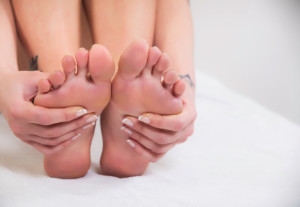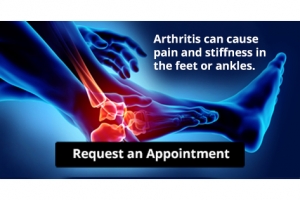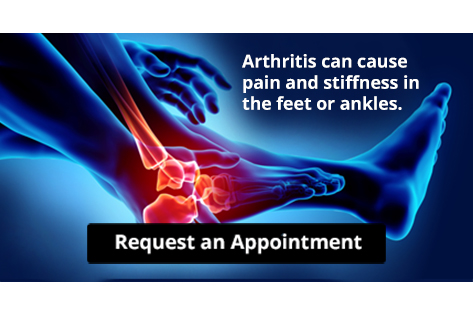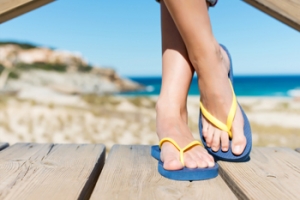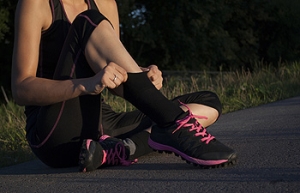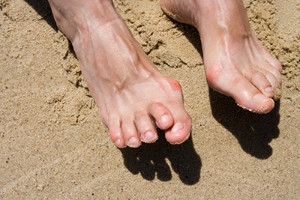Connect With Us
Featured Articles
Super User
Strengthening Flat Feet
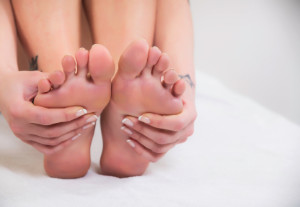 Flat feet often don’t cause any symptoms, however, they can make you more likely to develop foot problems over time. If you want to keep your feet healthy and in good condition, there are many stretching and strengthening exercises that you can try. Toe Scrunches work out the small muscles of the feet, making them stronger and more flexible at the arch. To do Toe Scrunches, place a towel on the floor and put your feet directly on top of it. Using only your toes, scrunch up the towel by moving your toes inward towards the balls of your feet. Another exercise you can do is called Can-Rolling. Sit on a chair and place a can lying down on the floor in front of you. Put your foot on top of the can so that the can is under your arch, then roll the can back and forth using your foot. This exercise stretches your feet while relieving tension and pressure. For more exercise ideas and information on strengthening flat feet, consult with a podiatrist.
Flat feet often don’t cause any symptoms, however, they can make you more likely to develop foot problems over time. If you want to keep your feet healthy and in good condition, there are many stretching and strengthening exercises that you can try. Toe Scrunches work out the small muscles of the feet, making them stronger and more flexible at the arch. To do Toe Scrunches, place a towel on the floor and put your feet directly on top of it. Using only your toes, scrunch up the towel by moving your toes inward towards the balls of your feet. Another exercise you can do is called Can-Rolling. Sit on a chair and place a can lying down on the floor in front of you. Put your foot on top of the can so that the can is under your arch, then roll the can back and forth using your foot. This exercise stretches your feet while relieving tension and pressure. For more exercise ideas and information on strengthening flat feet, consult with a podiatrist.
Flatfoot is a condition many people suffer from. If you have flat feet, contact Dr. Howard Horowitz from Bowie Foot & Ankle . Our doctor will treat your foot and ankle needs.
What Are Flat Feet?
Flatfoot is a condition in which the arch of the foot is depressed and the sole of the foot is almost completely in contact with the ground. About 20-30% of the population generally has flat feet because their arches never formed during growth.
Conditions & Problems:
Having flat feet makes it difficult to run or walk because of the stress placed on the ankles.
Alignment – The general alignment of your legs can be disrupted, because the ankles move inward which can cause major discomfort.
Knees – If you have complications with your knees, flat feet can be a contributor to arthritis in that area.
Symptoms
- Pain around the heel or arch area
- Trouble standing on the tip toe
- Swelling around the inside of the ankle
- Flat look to one or both feet
- Having your shoes feel uneven when worn
Treatment
If you are experiencing pain and stress on the foot you may weaken the posterior tibial tendon, which runs around the inside of the ankle.
If you have any questions please feel free to contact our office located in Bowie, MD. We offer the newest diagnostic and treatment technologies for all your foot and ankle needs.
Read more about Flat FeetFlat Feet
Flatfoot is a foot condition in which the arch of the foot has either partially or totally dropped or has never developed. While it is common in babies and small children, it can become a problem for them in adulthood if the arch never forms. For adults, the development of flat feet can be brought upon by injury, as a result of pregnancy due to increased elasticity, or obesity. Those who have health concerns such as rheumatoid arthritis or diabetes may also be at greater risk for developing the condition.
If you suspect that you have flat feet, it is best to consult your podiatrist. Your foot doctor will examine the suspected foot and observe how it looks while you sit and stand. He or she may take an X-ray to determine how serious the condition is. Some common signs of flatfoot include toe drift, in which the toes and front part of the foot point outward, a short Achilles tendon, and a heel that tilts outwardly while the ankle tilts inward.
Once flatfoot has been diagnosed, your podiatrist may suggest one of several treatment options. Flat feet can be rigid, in which the feet appear to have no arch even when the person is not standing; or flexible, in which the person appears to have an arch while not standing, but once standing the arch disappears. Those with flexible flatfoot may be told to reduce any activities that cause pain and to avoid extended periods of walking or standing. Another suggestion may be weight loss, as excessive weight may be placing pressure on the arches
In few cases, if the condition is severe and all other methods have been exhausted surgery may be required. This is normally avoided, however, due to a lengthy recovery time and high cost.
Arthritis Can Cause Pain in the Feet and Ankles
Are Flip-Flops Failing My Feet?
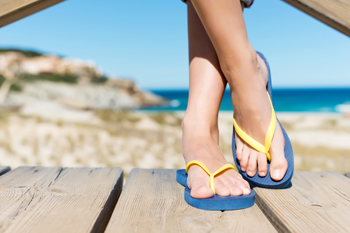 Flip-flops are a staple of summer footwear, especially at the beach or pool. However, wearing flip-flops may do more harm than good for the health of your foot. If you frequently wear flip-flops, you may notice that you have to constantly flex your toes to keep the shoes firmly on your feet. This toe flexing can lead to bunions and hammertoes, conditions that disfigure the joints of your toes. Flip-flops also provide very little support to your feet while you walk, potentially increasing your likelihood of foot and heel pain, especially if you have flat feet or fallen arches. Since flip-flops increase your feet’s exposure to the elements, you may also be at risk for developing fungal infections, like athlete’s foot and toenail fungus. If you must wear flip-flops, you may be able to avoid damage to your feet by wearing them only for short periods of time. For more information on the effects of flip-flops on your feet, and for treatment of any foot condition, consult with a podiatrist today.
Flip-flops are a staple of summer footwear, especially at the beach or pool. However, wearing flip-flops may do more harm than good for the health of your foot. If you frequently wear flip-flops, you may notice that you have to constantly flex your toes to keep the shoes firmly on your feet. This toe flexing can lead to bunions and hammertoes, conditions that disfigure the joints of your toes. Flip-flops also provide very little support to your feet while you walk, potentially increasing your likelihood of foot and heel pain, especially if you have flat feet or fallen arches. Since flip-flops increase your feet’s exposure to the elements, you may also be at risk for developing fungal infections, like athlete’s foot and toenail fungus. If you must wear flip-flops, you may be able to avoid damage to your feet by wearing them only for short periods of time. For more information on the effects of flip-flops on your feet, and for treatment of any foot condition, consult with a podiatrist today.
Flip-flops are not always the best choice of footwear. If you have any concerns about your feet or ankles, contact Dr. Howard Horowitz from Bowie Foot & Ankle . Our doctor will assist you with all of your foot and ankle needs.
Flip-Flops and Feet
When the weather starts warming up, people enjoy wearing flip-flops. Flip-flops are comfortable, stylish, and easy to slip on and off; they're perfect for any summer beach goer. However, these shoes can cause harm to the feet.
How Can Flip-Flops Affect Me Long-Term?
- Ankle problems
- Hip problems
- Lower back problems
- Pain in the balls of the feet
- Problems with foot arches
- Changes in the way you walk
Are There Injuries Associated with Flip-Flops?
Yes. Since flip-flops are relatively weak and do not provide the same amount of support as sneakers, people who wear flip-flops regularly are more susceptible to injuries. On top of that, the open nature of the shoe makes your feet more prone to other problems, such as cuts and even infections. Common injuries and ailments include:
- Sprained ankles
- Blisters
- Infections
- Cuts and Scrapes
I like Wearing Flip-Flops. Are There Safe Alternatives?
When buying flip-flops, try to find ones that have sturdy soles and that are made of high-quality materials that will support for your feet. These flip-flops will cost more but will also last longer as a result.
If you have any questions please feel free to contact our office located in Bowie, MD. We offer the newest diagnostic and treatment technologies for all your foot and ankle needs.
Read more about Flipping Out About Flip FlopsFlipping Out About Flip Flops
Although it may be tempting to wear flip-flops in warm weather, they are not the best choice of footwear for your feet. Flip-flops may be ideal for the beach, pool, spa, and shared showers, but you should avoid wearing them unless it is completely necessary.
Flip-flops only have a small strip of fabric holding your foot in place, but your toes need a better grip to keep your foot in place. The repetitive gripping can lead to an overuse of your muscles, which could result in tendinitis. This is only one of the many problems that stem from wearing flip-flops too often.
Flip flops aren’t good for extensive walking because they fail to offer arch support, heel cushioning, or shock absorption. As a result, people who wear flip flops are at a higher risk of experiencing an ankle sprain. Additionally, these shoes offer little protection for your feet, putting those who wear them at a greater risk for stubbed toes, glass cuts, and puncture wounds.
Although flip flops aren’t recommended for everyday use by anyone, it is especially important for diabetics to avoid them. A diabetic foot injury can easily become very serious, and it may even lead to amputation.
If you are experiencing pain from wearing flip-flops, you shouldn’t be hesitant to replace them with a more comfortable shoe that offers more support. If your flip-flop foot pain doesn’t go away, you should seek assistance from a podiatrist right away. It is possible that you may have a more serious foot problem such as a stress fracture or arthritis.
How to Find Shoes That Fit Right
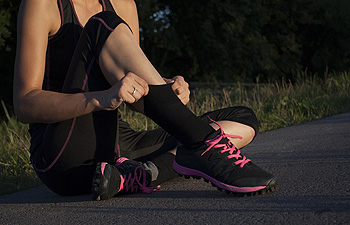 Did you know that your shoe size can change even in adulthood? Many people may actually be wearing shoes that are too big or too small because they are unaware of changes in the size of their feet. Wearing the wrong size shoe can lead to a variety of foot problems, from heel pain to hammertoes and everything in between. For this reason, it is important to have a proper shoe fitting. This can be achieved at a brick-and-mortar shoe store, where salespeople can assist you in finding the right size, and where you can try on the shoes for yourself before you buy them. Going shoe shopping later in the day, when your feet are at their largest, can help ensure that you purchase shoes that will fit your foot properly throughout the whole day. A podiatrist can also help you find the right shoes, can prescribe custom orthotics to correct certain foot problems, and can offer treatment for various foot conditions as needed.
Did you know that your shoe size can change even in adulthood? Many people may actually be wearing shoes that are too big or too small because they are unaware of changes in the size of their feet. Wearing the wrong size shoe can lead to a variety of foot problems, from heel pain to hammertoes and everything in between. For this reason, it is important to have a proper shoe fitting. This can be achieved at a brick-and-mortar shoe store, where salespeople can assist you in finding the right size, and where you can try on the shoes for yourself before you buy them. Going shoe shopping later in the day, when your feet are at their largest, can help ensure that you purchase shoes that will fit your foot properly throughout the whole day. A podiatrist can also help you find the right shoes, can prescribe custom orthotics to correct certain foot problems, and can offer treatment for various foot conditions as needed.
Finding a properly-fitting shoe is important in reducing injuries and preventing foot problems. For more information about treatment, contact Dr. Howard Horowitz from Bowie Foot & Ankle . Our doctor will treat your foot and ankle needs.
Proper Shoe Fitting
A common concern when it comes to foot health, having properly fitted shoes can help prevent injuries to the foot. Out feet affect our posture and gait, which in turn affects the biomechanics and overall bodily structure. With 33 joints, 26 bones, and over 100 ligaments, the potential for serious injury is much greater than one realizes. Although the feet cease growth in adulthood, they still change shape as they mature. Here are some factors to consider when it comes to investing in proper fitting shoes:
- Be sure the shoes fit correctly right away
- Ensure the ball of your foot fits comfortably in the widest portion of the shoes
- Even though they may look fashionable, improper fitting shoes can either create adverse conditions or exacerbate existing ones you may already have
- Walk along a carpeted surface to ensure the shoes comfortably fit during normal activity
Keeping in mind how shoes fit the biomechanics of your body, properly-fitting shoes are vitally important. Fortunately, it is not difficult to acquire footwear that fits correctly. Be sure to wear shoes that support the overall structure of your body. Do your feet a favor and invest in several pairs of well-fitted shoes today.
If you have any questions please feel free to contact our office located in Bowie, MD. We offer the newest diagnostic and treatment technologies for all your foot and ankle needs.
Read more about Proper Shoe FittingProper Shoe Fitting
When it comes to maintaining foot health, wearing properly-fitting shoes is important. While wearing the appropriate pair of shoes may seem like a trivial concern, the reality is that improperly fitted shoes cause an astounding amount of injuries to the feet. The overall structure and the biomechanics of our bodies are directly affected by our posture, gait, and feet. Because of this, pain and discomfort felt throughout the body are often related to a problem in the feet. And, most foot problems usually stem from improper footwear.
Shoes should not be purchased with the expectation that they will easily stretch and contort to the size and shape of your feet. When shopping for footwear, look for shoes that fit correctly and comfortably as soon as you put them on. Do not purchase shoes that are too large or that slip in the heel area when you walk. Do not choose shoes that are loose with the intention of wearing thicker socks to compensate for the space. The widest portion of the shoe, the ball of the foot, must be made sure to fit comfortably in the shoe.
Keeping all of these suggestions in mind may be difficult when shopping and when trying to select from a wide array of different shoes. Nonetheless, your time and money will be wasted if you purchase a pair of shoes that are too uncomfortable for you to actually wear them. After finally selecting and purchasing a pair of shoes, try them on at home. To truly ensure whether or not your shoes fit comfortably with normal activity, walk around on a carpeted surface to determine how they feel on your feet.
The possibility of damaging your feet’s 33 joints, 26 bones, and 100+ ligaments is much higher than many people suspect. Finding an appropriate and properly-fitted pair of shoes is perhaps the single most important action you can take to maintain excellent foot health and help prevent injury. The fact that our feet continue to change with age is one that many people often forget. Even if our feet no longer change in size when we mature, our feet will still change in shape.
If you already have pre-existing foot problems, there is a greater possibility that wearing improperly-fitted shoes will worsen those problems. The good news, however, is that appropriate footwear is not difficult to find. While shopping for shoes, remember that improper footwear can detrimentally affect the feet, the entire body and its biomechanical structure as well. The shoes you wear can greatly impact your legs, back, and entire body, as your posture and gait are related to your feet. Finding and selecting the best properly-fitted shoes is necessary in achieving optimal health.
The Ankle-Brachial Index
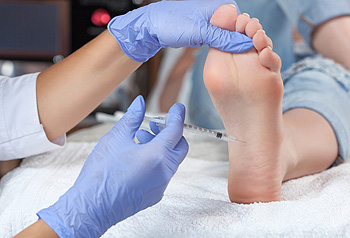 The ankle-brachial index (ABI) is a quick and non-invasive form of vascular testing that your podiatrist may perform during a routine visit. It is frequently used to assess the presence or severity of peripheral artery disease, a potentially dangerous condition that results in poor circulation to the lower limbs. The ankle-brachial index test is performed in several steps. Similarly to typical checkups at your physician’s office, first, the doctor will measure your blood pressure around your upper arm. Then, the doctor will measure your blood pressure around your ankle. The two numbers are compared to find the ankle-brachial index value, a number that is used to determine the presence or severity of peripheral artery disease. The lower the ABI value is, the greater the chance that you have arterial disease. If you suspect you have poor circulation to your lower limbs, it is recommended that you visit a podiatrist, who can perform an ankle-brachial index test, as well as other vascular tests to assess blood flow to your feet and ankles.
The ankle-brachial index (ABI) is a quick and non-invasive form of vascular testing that your podiatrist may perform during a routine visit. It is frequently used to assess the presence or severity of peripheral artery disease, a potentially dangerous condition that results in poor circulation to the lower limbs. The ankle-brachial index test is performed in several steps. Similarly to typical checkups at your physician’s office, first, the doctor will measure your blood pressure around your upper arm. Then, the doctor will measure your blood pressure around your ankle. The two numbers are compared to find the ankle-brachial index value, a number that is used to determine the presence or severity of peripheral artery disease. The lower the ABI value is, the greater the chance that you have arterial disease. If you suspect you have poor circulation to your lower limbs, it is recommended that you visit a podiatrist, who can perform an ankle-brachial index test, as well as other vascular tests to assess blood flow to your feet and ankles.
Vascular testing plays an important part in diagnosing disease like peripheral artery disease. If you have symptoms of peripheral artery disease, or diabetes, consult with Dr. Howard Horowitz from Bowie Foot & Ankle . Our doctor will assess your condition and provide you with quality foot and ankle treatment.
What Is Vascular Testing?
Vascular testing checks for how well blood circulation is in the veins and arteries. This is most often done to determine and treat a patient for peripheral artery disease (PAD), stroke, and aneurysms. Podiatrists utilize vascular testing when a patient has symptoms of PAD or if they believe they might. If a patient has diabetes, a podiatrist may determine a vascular test to be prudent to check for poor blood circulation.
How Is it Conducted?
Most forms of vascular testing are non-invasive. Podiatrists will first conduct a visual inspection for any wounds, discoloration, and any abnormal signs prior to a vascular test.
The most common tests include:
- Ankle-Brachial Index (ABI) examination
- Doppler examination
- Pedal pulses
These tests are safe, painless, and easy to do. Once finished, the podiatrist can then provide a diagnosis and the best course for treatment.
If you have any questions, please feel free to contact our office located in Bowie, MD. We offer the newest diagnostic and treatment technologies for all your foot care needs.
Read more about Vascular Testing in Podiatry
Vascular Testing in Podiatry
In foot care, vascular testing may be required in the diagnosing and treatment of certain podiatric conditions. Vascular testing is particularly relevant for patients with high-risk diabetes, poor circulation, peripheral artery disease (PAD), and chronic venous insufficiency (CVI). Procedures typically involve the examination of blood vessels throughout the body for blockages or buildup.
Vascular testing is very important for the diagnosis of various conditions, including peripheral artery disease and chronic venous insufficiency, as these conditions can greatly affect one’s quality of life and cause pain in the lower limbs. Circulatory problems in the feet and ankles can reflect issues throughout the body, making testing of the blood vessels pertinent.
Testing methods vary between practitioners and can be specific to certain foot and ankle problems. Modern technology has brought about the ability to perform vascular testing using non-invasive methods, such as the cuff-based PADnet testing device. This device records the Ankle-Brachial Index (ABI)/Toe-Brachial Index (TBI) values and Pulse Volume Recording (PVR) waveforms. Contact your podiatrist to determine what vascular testing is available for your needs.
Common Reasons a Hammertoe May Develop
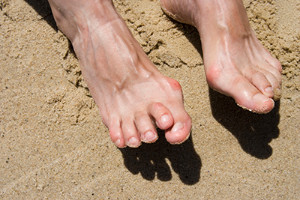 Hammertoes, as its name suggests, may cause the affected toe to bend downward, resembling a hammer-like shape. Typically, this condition can affect the second, third, or fourth toes. Because hammertoes can be painful and cause a great deal of discomfort, it’s important that you seek professional help if you notice your toe’s appearance has become deformed. Common causes for a hammertoe’s development include a muscle imbalance, tightly-fitted footwear, a previous injury, and certain diseases such as arthritis or diabetes. Along with the noticeable change of appearance of the affected toe, some may also experience swelling, redness, a burning sensation, and the development of corns or calluses on the top of the middle joint of the affected toe. For more advice on how to treat a hammertoe, please seek the professional guidance of a podiatrist.
Hammertoes, as its name suggests, may cause the affected toe to bend downward, resembling a hammer-like shape. Typically, this condition can affect the second, third, or fourth toes. Because hammertoes can be painful and cause a great deal of discomfort, it’s important that you seek professional help if you notice your toe’s appearance has become deformed. Common causes for a hammertoe’s development include a muscle imbalance, tightly-fitted footwear, a previous injury, and certain diseases such as arthritis or diabetes. Along with the noticeable change of appearance of the affected toe, some may also experience swelling, redness, a burning sensation, and the development of corns or calluses on the top of the middle joint of the affected toe. For more advice on how to treat a hammertoe, please seek the professional guidance of a podiatrist.
Hammertoe
Hammertoes can be a painful condition to live with. For more information, contact Dr. Howard Horowitz from Bowie Foot & Ankle . Our doctor will answer any of your foot- and ankle-related questions.
Hammertoe is a foot deformity that affects the joints of the second, third, fourth, or fifth toes of your feet. It is a painful foot condition in which these toes curl and arch up, which can often lead to pain when wearing footwear.
Symptoms
- Pain in the affected toes
- Development of corns or calluses due to friction
- Inflammation
- Redness
- Contracture of the toes
Causes
Genetics – People who are genetically predisposed to hammertoe are often more susceptible
Arthritis – Because arthritis affects the joints in your toes, further deformities stemming from arthritis can occur
Trauma – Direct trauma to the toes could potentially lead to hammertoe
Ill-fitting shoes – Undue pressure on the front of the toes from ill-fitting shoes can potentially lead to the development of hammertoe
Treatment
Orthotics – Custom made inserts can be used to help relieve pressure placed on the toes and therefore relieve some of the pain associated with it
Medications – Oral medications such as anti-inflammatories or NSAIDs could be used to treat the pain and inflammation hammertoes causes. Injections of corticosteroids are also sometimes used
Surgery – In more severe cases where the hammertoes have become more rigid, foot surgery is a potential option
If you have any questions please contact our office located in Bowie, MD. We offer the newest diagnostic and treatment technologies for all your foot and ankle needs.
Read more about What Are Hammertoes?